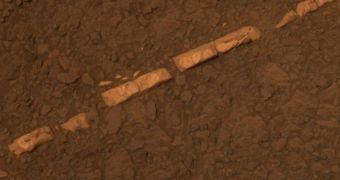Mars Exploration Rover (MER) mission controllers at the NASA Jet Propulsion Laboratory (JPL) published a new paper in the May 4 issue of the top journal Science, detailing rover Opportunity's science operations at Endeavour Crater over the first four months since the robot got there.
The vehicle completed its initial, 3-month mission more than 8 years ago, and has been conducting scientific operations at the Red Planet ever since. It traveled more than 30 kilometers from where it landed, and has eventually made its way to Endeavour Crater after three years of driving.
It arrived at its rim last year, and immediately began to investigate the location. The crater itself is 22 kilometers (14 miles) in diameter, and geologists estimate its age at around 4 billion years. Some of the results the rover obtained were presented at a conference in late 2011.
In the new paper, the team presents a potential mechanism to explain the formation of mineral gypsum that Opportunity discovered in ground cracks at crater rim. The rover found these deposits between fused-together rock fragments on Endeavour's rim.
The latter were most likely produced by the initial asteroid impact that created this landscape feature. It would now appear that the impactor released and heated water that was trapped underground, a phenomenon that in turn led to the deposition of zinc in the rocks.
Cooled-down water then flowed through recently developed cracks in the ground, and deposited mineral gypsum at the locations Endeavour analyzed around 4 billion years later. The machine is currently parked on an outcrop on the crater's rim called Greeley Haven.
“These bright mineral veins are different from anything seen previously on Mars, and they tell a clear story of water flowing through cracks in the rocks,” Cornell University professor and MER principal science investigator, Steve Squyres, explains.
He is also the lead author of the new Science paper, on which a team of 27 researchers contributed.
“From landing until just before reaching the Endeavour rim, Opportunity was driving over sandstone made of sulfate grains that had been deposited by water and later blown around by the wind,” Squyres explains.
“These gypsum veins tell us about water that flowed through the rocks at this exact spot. It's the strongest evidence for water that we've ever seen with Opportunity,” he concludes.
Opportunity will soon be joined by the Mars Science Laboratory (MSL) rover Curiosity, which is scheduled to land at Gale Crater in early August.

 14 DAY TRIAL //
14 DAY TRIAL //